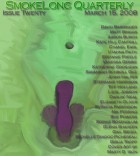Lately, I’ve been into fiction with a contemporary feel. In “Favorites” you open the story with a reference to American Idol, and then go on to mention the iPod. Is it important to anchor the reader to a specific time period?
It depends on the story’s ambitions. Some moments are timeless and inserting a ‘contemporary’ reference could make it feel dated too soon, especially since technology evolves so quickly. Brand names and other allusions can be a distraction in a flash that’s mostly dialogue, or in crisis-story like a car accident. But they can create a mood, an aura. If a character is dusting off an LP or boarding a carriage or drinking “Tang”, that provides atmosphere. In “Favorites,” technology—who has it and who does not—is the essence of the plot. It is linked to class, to desire, isolation and alienation. There, it felt indispensable.
Incidentally, I have an iPod but I don’t watch American Idol, though after I wrote “Favorites,” I saw a 5 minute segment with my husband. A young woman did a terrific job singing, and was then promptly humiliated by the judges. It was painful to witness, simply torture.
Laurie’s favorite number is ten. As in a perfect ten, maybe?
Ha! I didn’t think of that. I’ve always liked even numbers, and 10 seemed like it would appeal to a child. Ambitious, but small enough to count on two hands.
What are you imparting upon the reader by using the word “teevee” instead of TV or television?
My intuition told me that Laurie’s consciousness was ‘pre-acronym’. That she still thought in sounds and images, not letters. It’s a more innocent consciousness, before children abandon drawing and begin thinking in typeface. “Teevee” conveys less sophistication. A child without a TV might not be as worldly, in a commercial sense.
You write non-fiction as well. What type of non-fiction do you write? Articles, essays, creative non-fiction, etc.?
In my struggling literary life, I’ve written nonfiction that reads like fiction, and has been in journals like Pindeldyboz and Salamander. I’m not an essayist. But in my paid-professional life, I write, too: speeches, press releases, reports. I’ve written reams for other people, which is standard in politics. Editorials where the Cook County Clerk reminisces about the late Mayor Harold Washington have my stamp on them.
While reading through the annual Kathy Fish Fellowship applications, I was struck by the number of writers who were using flash as, to paraphrase, a means to an end. Most people weren’t writing flash because they loved the form, because it took them places other types of fiction didn’t. Instead, they were using it as a gateway into longer works—short stories, short story collections, novels. As a champion of flash, I found this discouraging. Is flash fiction less satisfying, in terms of either writing or reading, than longer works? Or is it that the markets still haven’t accepted flash as a legitimate form? Why do you write flash, and where do you see it taking you?
How can anyone write flash who doesn’t love it? That seems perverse. I love the flash form and have been writing it since I started writing fiction. Although I have collection of longer stories I hope to publish, I only write short pieces right now.
That said, I have written series of flashes about the same character, and strung some into longer pieces (“About Marguerite” in Quay). A number of flashes can feel ‘sprung’ from the same character, and it makes sense to cluster them. But when I write a flash, I don’t write it as a ‘chapter’. I try to capture a moment that stands alone. Cobbling together 20 or 40 of my flashes into a book might feel choppy; I’m not sure. I would love to explore that—not as a means to an end, but because there is something inherently pleasurable about expanding a fictional character’s universe. Maybe that’s why writers from Updike to Paretsky write book after book with the same protagonist.
As a reader, I don’t favor one form over another, but flashes and short stories are a perfect escape—transporting—during my commute. And I’m no expert in markets. I don’t publish or even submit very much. But Amy Hempel’s Collected Stories did exceptionally well in 2006, and that should be encouraging to all those flashers out there.



 The core workshop of SmokeLong Fitness is all in writing, so you can take part from anywhere at anytime. We are excited about creating a supportive, consistent and structured environment for flash writers to work on their craft in a community. We are thrilled and proud to say that our workshop participants have won, placed, or been listed in every major flash competition. Community works.
The core workshop of SmokeLong Fitness is all in writing, so you can take part from anywhere at anytime. We are excited about creating a supportive, consistent and structured environment for flash writers to work on their craft in a community. We are thrilled and proud to say that our workshop participants have won, placed, or been listed in every major flash competition. Community works.